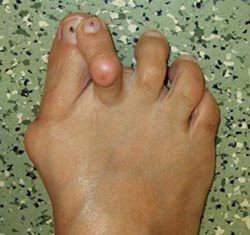 What is a Hammer Toe?
What is a Hammer Toe?
A hammer toe is a deformity of the toe, usually the second, in which the toe becomes curled over.
Why do they develop?
Hammer toe formation occurs often due to a number of different factors, ill fitting shoes are thought to play a part in number of cases; other factors thought to be involved are female sex, high heeled shoes, inflammatory conditions and muscle imbalance.
There is a belief by some that they may develop following a period of inflammation of the joint at the base of the toe, which can lead to incompetence of the soft tissues underneath the joint, as a result the tendons become imbalanced and the toe curls.
Inflammation of this joint occurs for many reason- there may be an injury, it may be due to a painful big toe (“first ray”) due to arthritis (See: Hallux Rigidus) or because the big toe does not function normally which is the case in the presence of some bunions (See: Hallux Valgus).
What symptoms do they cause?
Pain: top of the first joint in the toe becomes prominent and rubs on shoes leading to pain and inflammation, this can occasionally this can lead to ulceration.
Crossing over: the deformity may become severe and as well as curling up the toe may start to deviate to the side and may cross over the neighbouring toe (see photo).
What options are there for treatment?
a. Shoes
Shoes with soft uppers may decrease the irritation of the hammer toe, if this is not sufficient then shoes with a deep toe box (i.e. with more space top to bottom for the toes).
b. Silicone toe sleeve
These fit over the toes and provide cushioning and protect against rubbing on the shoes, which may ease the discomfort. They may also decrease the likelihood of ulceration.
c. Surgery
This is involves straightening the toe. It is usually performed as a day case procedure. It involves a number of steps, the exact procedure being dependant on the severity of the deformity and is discussed further one the hammer toe correction page.
